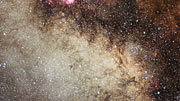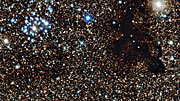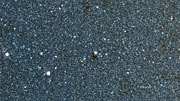Comunicato Stampa
"Una goccia d'inchiostro nel cielo luminoso"
Il WFI (Wide Field Imager) cattura un geco cosmico
13 Febbraio 2013
Questa immagine ottenuta con il WFI (Wide Field Imager) montato sul telescopio da 2,2 metri dell'MPG/ESO all'Osservatorio dell'ESO di La Silla, in Cile, mostra il luminoso ammasso stellare NGC 6520 e il suo vicino, la strana nube oscura, a forma di geco, nota come Barnard 86. Questo duo cosmico si staglia su un sfondo di milioni di stelle incandescenti della zona più luminosa della Via Lattea - una regione così densa di stelle che quasi non si vede un pezzetto di cielo libero, in questa fotografia.
Questa parte della costellazione del Sagittario è uno dei campi stellari più ricchi dell'intero cielo - la Grande Nube Stellare del Sagittario. L'enorme numero di stelle che illuminano questa regione enfatizza l'oscurità di nubi oscure come Barnard 86, che si vede al centro di questa nuova immagine ottenuta dal WFI (Wide Field Imager), uno strumento montato sul telescopio da 2,2 metri dell'MPG/ESO all'Osservatorio dell'ESO di La Silla, in Cile.
Questo oggetto, una piccola e isolata nebulosa oscura nota come un "globulo di Bok" [1], è stato descritto come "una goccia d'inchiostro nel cielo luminoso" dal suo scopritore, Edward Emerson Barnard [2], un astronomo americano che ha scoperto e fotografato numerose comete e nebulose oscure, una della lune di Giove, e molto altro. Osservatore eccezionale e appassionato astro-fotografo, Barnard è stato il primo a utilizzare lunghe pose fotografiche per esplorare le nebulose oscure.
Attraverso un piccolo telescopio, Barnard 86 appare come una mancanza di stelle, una finestra su un piccolo pezzo di cielo sgombro, più distante. In realtà questo oggetto sta davanti al campo stellare - una nube fredda, scura e densa composta da piccoli grani di polvere che bloccano la luce delle stelle e rendono opaca la regione. Si pensa che si sia formata dai resti di una nube molecolare collassata per formare il vicino ammasso stellare NGC 6520, che si vede a sinistra di Barnard 86 in questa immagine.
NGC 6520 è un ammasso aperto che contiene molte stelle calde che risplendono di luce bianco-azzurra, un segno inequivocabile della loro giovinezza. Gli ammassi aperti di solito contengono poche migliaia di stelle che si sono formate tutte allo stesso tempo e perciò hanno la stessa età. Questi ammassi di solito vivono relativamente poco, dell'ordine di diverse centinaia di milioni di anni, prima di disgregarsi.
L'incredibile numero di stelle in questa zona di cielo complica le osservazioni dell'ammasso, rendendo difficile imparare molto su di esso. Si pensa che l'età di NGC 6520 sia di circa 150 milioni di anni e che sia l'ammasso stellare che il vicino ricco di polvere si trovino ad una distanza di circa 6000 anni luce dal nostro Sole.
Le stelle che appaiono in Barnard 86 in questa immagine si trovano in realtà di fronte ad esso, cioè tra noi e la nube oscura. Anche se non sappiamo se questo sia vero per Barnard 86, molte nebulose oscure ospitano nuove stelle in formazione all'interno - come ad esempio nella famosa Nebulosa Testa di Cavallo (eso0202), nell'appariscente oggetto Lupus 3 (eso1303) e in qualche misura anche in un'altra delle scoperte di Barnard, la Nebulosa Pipa (eso1233). Tuttavia, la luce delle stelle più giovani è bloccata dalle zone di polvere circostanti, cosa che le rende visibili solo in luce infrarossa o di lunghezza d'onda maggiore.
Note
[1] I globuli di Bok sono stati osservati per la prima volta nel 1940 dall'astronomo Bart Bok. Sono nubi molto fredde e scure di gas e polvere che spesso contengono nuove stelle in formazione. Questi globuli sono ricchi di polveri che disperdono e assorbono la luce di fondo, diventando così quasi opachi alla radiazione visibile.
[2] Questa citazione è tratta da E. E. Barnard, Dark Regions in the Sky Suggesting an Obscuration of Light ("Regioni oscure in cielo suggeriscono l'oscuramento della luce"), Yerkes Observatory, 15 Nov 1913 (disponibile online qui).
Ulteriori Informazioni
L'ESO (European Southern Observatory, o Osservatorio Australe Europeo) è la principale organizzazione intergovernativa di Astronomia in Europa e l'osservatorio astronomico più produttivo al mondo. È sostenuto da 15 paesi: Austria, Belgio, Brasile, Danimarca, Finlandia, Francia, Germania, Gran Bretagna, Italia, Olanda, Portogallo, Repubblica Ceca, Spagna, Svezia, e Svizzera. L'ESO svolge un ambizioso programma che si concentra sulla progettazione, costruzione e gestione di potenti strumenti astronomici da terra che consentano agli astronomi di realizzare importanti scoperte scientifiche. L'ESO ha anche un ruolo di punta nel promuovere e organizzare la cooperazione nella ricerca astronomica. L'ESO gestisce tre siti osservativi unici al mondo in Cile: La Silla, Paranal e Chajnantor. Sul Paranal, l'ESO gestisce il Very Large Telescope, osservatorio astronomico d'avanguardia nella banda visibile e due telescopi per survey. VISTA, il più grande telescopio per survey al mondo, lavora nella banda infrarossa mentre il VST (VLT Survey Telescope) è il più grande telescopio progettato appositamente per produrre survey del cielo in luce visibile. L'ESO è il partner europeo di un telescopio astronomico di concetto rivoluzionario, ALMA, il più grande progetto astronomico esistente. L'ESO al momento sta progettando l'European Extremely Large Telescope o E-ELT (significa Telescopio Europeo Estremamente Grande), un telescopio da 39 metri che opera nell'ottico e infrarosso vicino e che diventerà "il più grande occhio del mondo rivolto al cielo".
Links
- Informazioni sul telescopio da 2,2 metri dell'MPG/ESO
- Informazioni sull'Osservatorio di La Silla
- Immagini di La Silla
Contatti
Richard Hook
ESO, La Silla, Paranal, E-ELT and Survey Telescopes Public Information Officer
Garching bei München, Germany
Tel.: +49 89 3200 6655
Cell.: +49 151 1537 3591
E-mail: rhook@eso.org
Joerg Gasser (press contact Svizzera)
Rete di divulgazione scientifica dell'ESO
E-mail: eson-switzerland@eso.org
Sul Comunicato Stampa
| Comunicato Stampa N": | eso1307it-ch |
| Nome: | Barnard 86, NGC 6520 |
| Tipo: | Milky Way : Star : Grouping : Cluster : Open Milky Way : Nebula : Appearance : Dark : Bok Globule |
| Facility: | MPG/ESO 2.2-metre telescope |
| Instruments: | WFI |
Our use of Cookies
We use cookies that are essential for accessing our websites and using our services. We also use cookies to analyse, measure and improve our websites’ performance, to enable content sharing via social media and to display media content hosted on third-party platforms.
ESO Cookies Policy
The European Organisation for Astronomical Research in the Southern Hemisphere (ESO) is the pre-eminent intergovernmental science and technology organisation in astronomy. It carries out an ambitious programme focused on the design, construction and operation of powerful ground-based observing facilities for astronomy.
This Cookies Policy is intended to provide clarity by outlining the cookies used on the ESO public websites, their functions, the options you have for controlling them, and the ways you can contact us for additional details.
What are cookies?
Cookies are small pieces of data stored on your device by websites you visit. They serve various purposes, such as remembering login credentials and preferences and enhance your browsing experience.
Categories of cookies we use
Essential cookies (always active): These cookies are strictly necessary for the proper functioning of our website. Without these cookies, the website cannot operate correctly, and certain services, such as logging in or accessing secure areas, may not be available; because they are essential for the website’s operation, they cannot be disabled.
Functional Cookies: These cookies enhance your browsing experience by enabling additional features and personalization, such as remembering your preferences and settings. While not strictly necessary for the website to function, they improve usability and convenience; these cookies are only placed if you provide your consent.
Analytics cookies: These cookies collect information about how visitors interact with our website, such as which pages are visited most often and how users navigate the site. This data helps us improve website performance, optimize content, and enhance the user experience; these cookies are only placed if you provide your consent. We use the following analytics cookies.
Matomo Cookies:
This website uses Matomo (formerly Piwik), an open source software which enables the statistical analysis of website visits. Matomo uses cookies (text files) which are saved on your computer and which allow us to analyze how you use our website. The website user information generated by the cookies will only be saved on the servers of our IT Department. We use this information to analyze www.eso.org visits and to prepare reports on website activities. These data will not be disclosed to third parties.
On behalf of ESO, Matomo will use this information for the purpose of evaluating your use of the website, compiling reports on website activity and providing other services relating to website activity and internet usage.
Matomo cookies settings:
Additional Third-party cookies on ESO websites: some of our pages display content from external providers, e.g. YouTube.
Such third-party services are outside of ESO control and may, at any time, change their terms of service, use of cookies, etc.
YouTube: Some videos on the ESO website are embedded from ESO’s official YouTube channel. We have enabled YouTube’s privacy-enhanced mode, meaning that no cookies are set unless the user actively clicks on the video to play it. Additionally, in this mode, YouTube does not store any personally identifiable cookie data for embedded video playbacks. For more details, please refer to YouTube’s embedding videos information page.
Cookies can also be classified based on the following elements.
Regarding the domain, there are:
- First-party cookies, set by the website you are currently visiting. They are stored by the same domain that you are browsing and are used to enhance your experience on that site;
- Third-party cookies, set by a domain other than the one you are currently visiting.
As for their duration, cookies can be:
- Browser-session cookies, which are deleted when the user closes the browser;
- Stored cookies, which stay on the user's device for a predetermined period of time.
How to manage cookies
Cookie settings: You can modify your cookie choices for the ESO webpages at any time by clicking on the link Cookie settings at the bottom of any page.
In your browser: If you wish to delete cookies or instruct your browser to delete or block cookies by default, please visit the help pages of your browser:
Please be aware that if you delete or decline cookies, certain functionalities of our website may be not be available and your browsing experience may be affected.
You can set most browsers to prevent any cookies being placed on your device, but you may then have to manually adjust some preferences every time you visit a site/page. And some services and functionalities may not work properly at all (e.g. profile logging-in, shop check out).
Updates to the ESO Cookies Policy
The ESO Cookies Policy may be subject to future updates, which will be made available on this page.
Additional information
For any queries related to cookies, please contact: pdprATesoDOTorg.
As ESO public webpages are managed by our Department of Communication, your questions will be dealt with the support of the said Department.







